Tillandsia pfeufferi or Tillandsia Pfantom
Click thumbnails for full size, scaled to a new window.
Tillandsia pfeufferi or Tillandsia Pfantom
An extremely rare plant. Likely to be a species, or possibly a variety of T. zecheri, or from the T. zecheri and T. lorentziana complex.
Considered by Walter Till to be a hybrid between T. lorentziana and T. vernicosa and hence is also listed in cultivars by the name Tillandsia Pfantom.
Please see the 'Uncle Derek Says' notes for Tillandsia pfeufferi on the fcbs website for more details.
See also 'Detective Derek' DD1008 Natural Hybrids talk, and
EG 02/20: Natural Hybrids of T. argentina & others previously published as species, Eric Gouda.
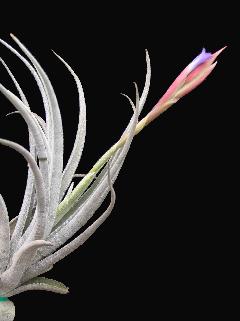
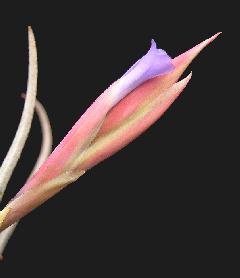
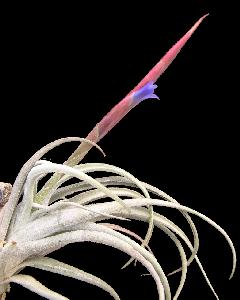

| Ken Woods 03/06 as pfeufferi. |
Ken Woods 02/09 as Pfantom. |
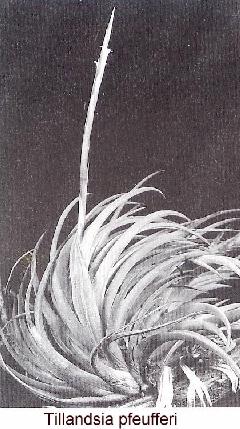
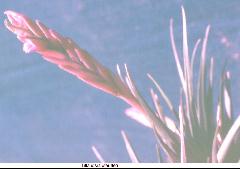
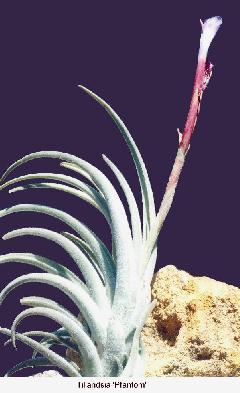
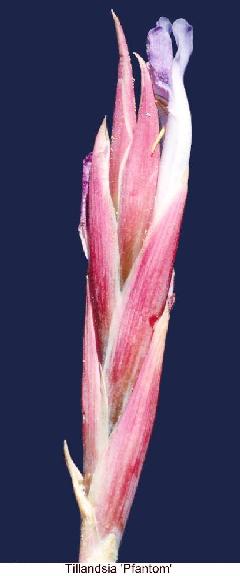
| pfeufferi, Rauh 10/08. |
pfeufferi, Colgan 10/08. |
Pfantom 10/08. |
Pfantom 10/08. |
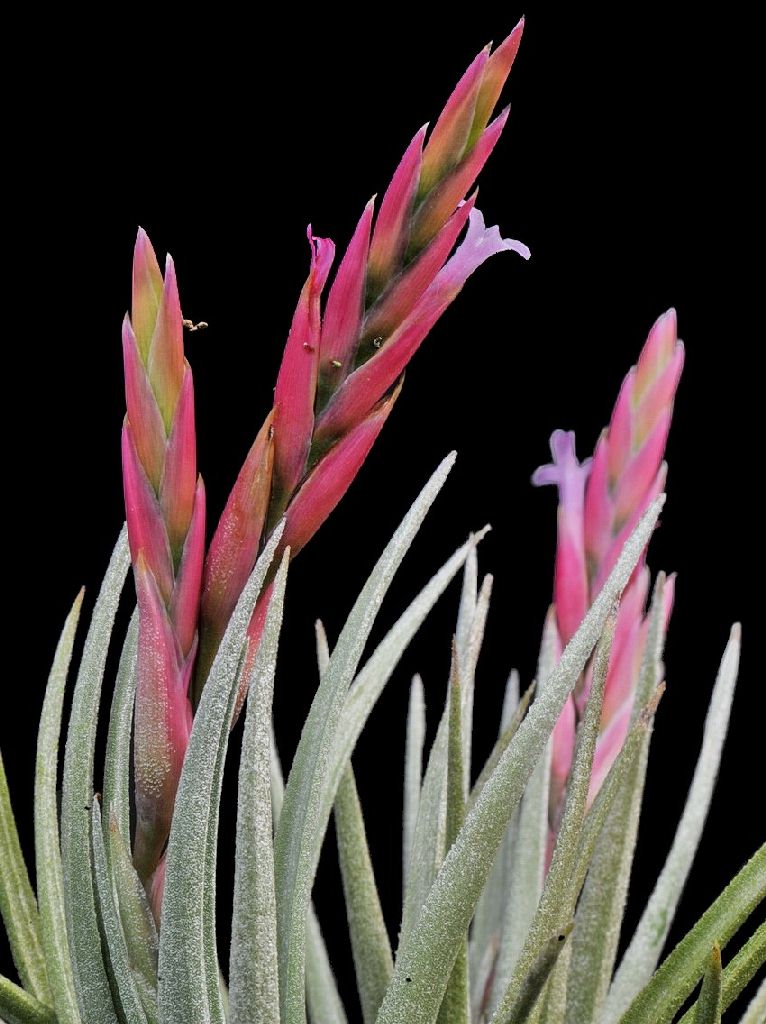
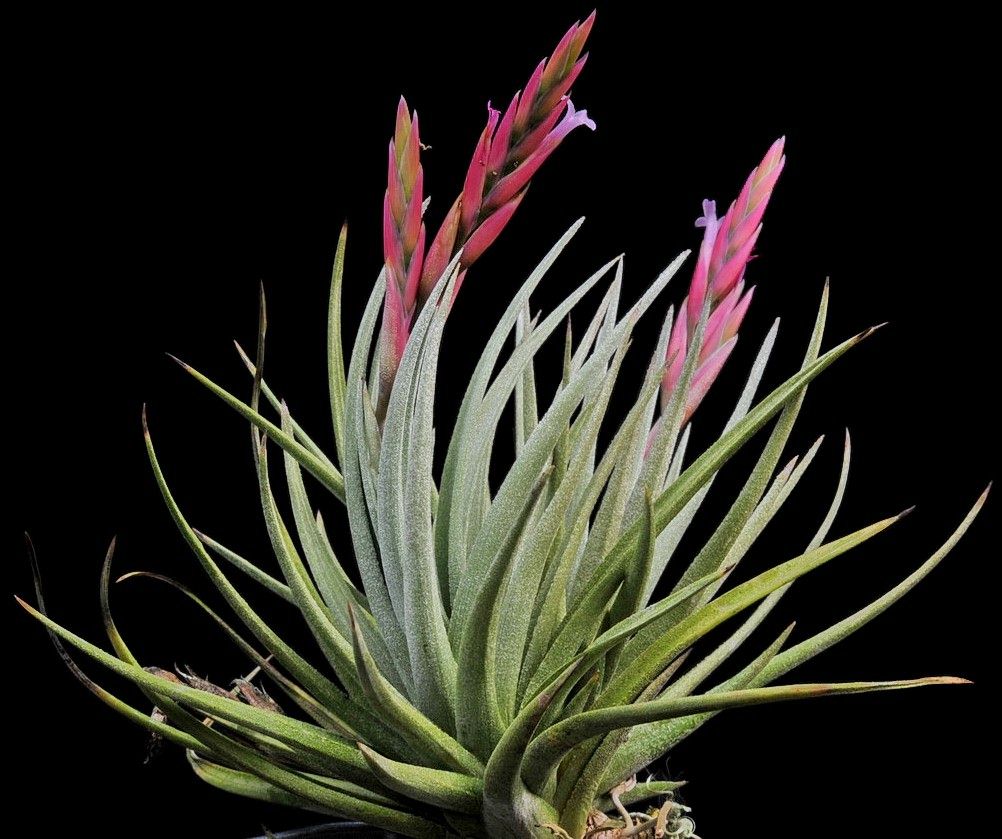

| pfeufferi, Peter Tristram 03/13. |
Pfantom, Chris Larson 10/15 |


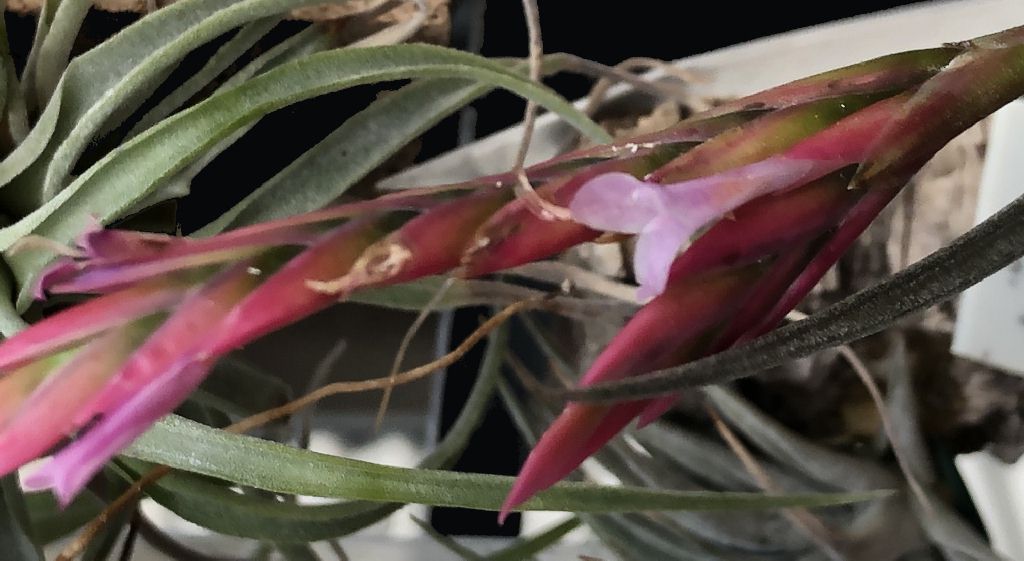
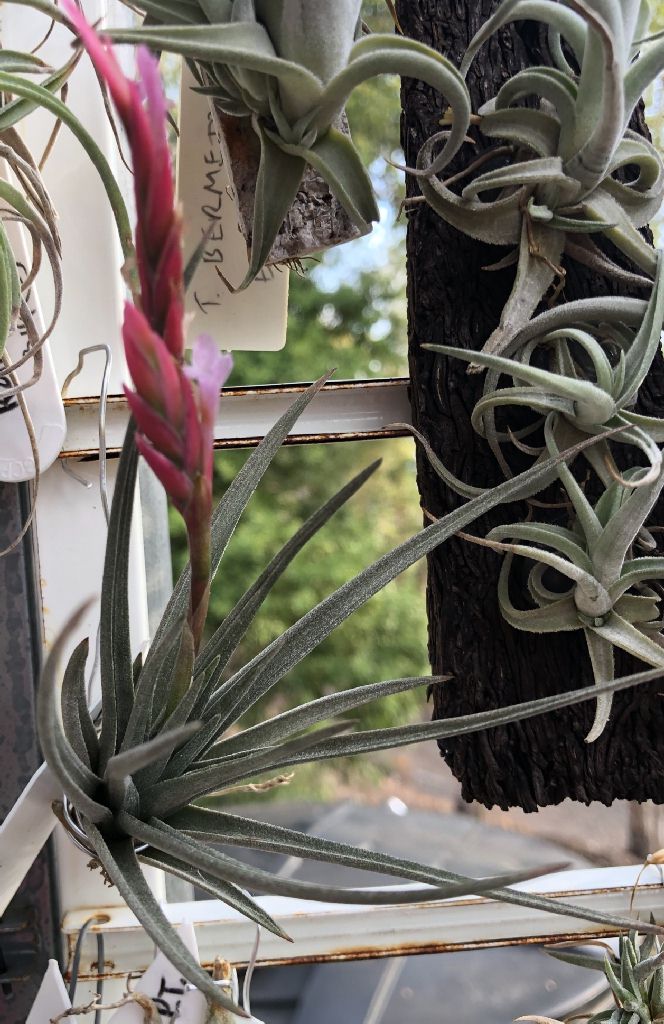
| pfeufferi ex LH, Dale Dixon 10/19 |
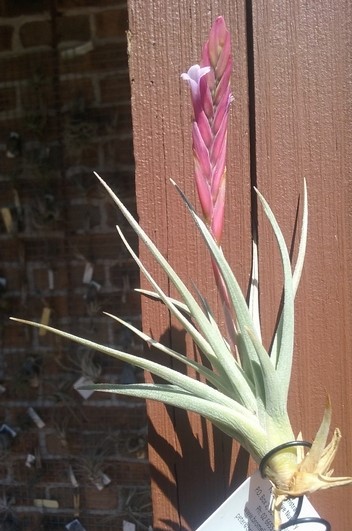
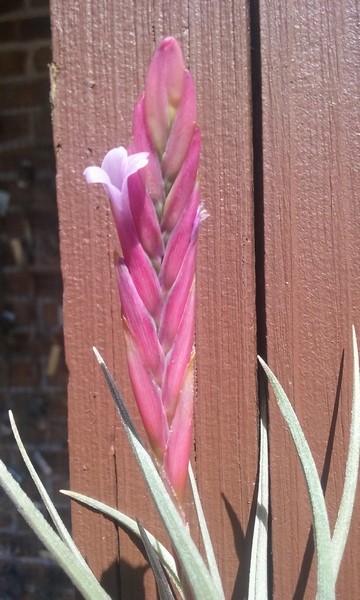
Tillandsia pfeufferi Rauh W. Trop. Subtrop Pflanz. 65: 61-3. 1988
Tillandsiae lorentzianae Grisebach propinqua, sed ab ea differt characteribus sequentibus: Planta acaulis, numquam caulescens, folia numerosa in rosulam densam saepe homo mallam disposita. Laminae anguste lineares, tantum usque ad 1 cm latae. Inflorescentia simplex, ensiformis. Bracteae florales leves, tantum in statu sicco leviter nervatae. Flores minores tantum usque ad 25 mm longi. Petala pallide lilacina.
Holotypus : B.G.H. 68820, leg. D. Muhr (Buenos Aires, Argentinien, August 1987), in herb. inst. bot. system. univ. heidelb. (HEID).
Patria et distributio: epiphytica in parietibus rupium prope Entre Rios, Prov. Jujuy, 1800 m.s.m., Argentina, unacum Tillandsia didisticha (E: Morren) Baker.
PLANT - Growing epiphytically on rocks. Stemless, flowering to 17 cm high, leaves numerous, mostly secund, making a rosette 13cm high, 12cm wide.
LEAF SHEATH - More or less distinguishable, oval, pale, 1.5cm high, 1.3cm wide, naked at the base, otherwise both sides densely appressed lepidote.
LEAF BLADE - Thin three angled, acuminate, ca 11cm long, 1cm wide near the sheath, canaliculate, both sides dense white lepidote, scales more or less spreading.
SCAPE - Shorter or as long as the leaf rosette, erect, 6cm long, round thin.
SCAPE BRACTS - Densely imbricate, the bottom ones leaf like, the upper ones long lancelike, acuminate. At first light brown, when dry nerved, lepidote, longer than the internodes.
INFLORESCENCE - Simple, swordshaped, 6.5cm long, 1cm. wide, ca 10 flowered.
FLOWER - Erect-spreading, subsessile, distichous, 2.5cm long.
FLOWER BRACTS - Erect, imbricate, (rhachis visible) thin, acuminate, 2-1.5cm long, exceed slightly the sepals, not keeled but tips occasionally keeled, the base at first light brown, nerved when dry, scattered lepidote, the top shiny carmine red, fresh bare, naked.
SEPALS - Free, thin lancelike, acuminate, the posterior pair keeled, 12mm long, naked, light carmine red, at the bottom green.
PETALS - Tongue shaped, dull, spreading, 2.5cm long, at the bottom white otherwise pale lilac colour.
STAMENS & STYLE - Deeply enclosed, filament plicate, white, pollen yellow. Stigma lobes overhang the stamens, with small, white, papillae.
HOLOTYPE - B G H 68 820, leg. D Muhr ( Buenos Aires, Argentina Aug. 1987) HEID
HABITAT - Argentina, Jujuy near Entre Rios, 1800m. found with T. didisticha (E Morren) Baker
Named after Franz J Pfeuffer, Giebelstadt, Germany who found the plant in a batch of imported T. didisticha
DIFFERS FROM T. LORENTZIANA IN THAT
1- Plant has no stem, never caulescent.
2- Numerous leaves in a dense rosette mostly secund.
3- Leaf blade narrow linear, barely 1cm wide.
4- Inflorescence simple, sword shaped.
5- Floral bracts flat, barely nerved in a dry state.
6- Flowers smaller, barely 25mm long.
7- Petals pale lilac.
According to Walter Till probably a natural hybrid between T. lorentziana and T. vernicosa
Tillandsia ‘Pfantom’ 1997
by Derek Butcher
This starts in the early 1990’s, when I had a request from Ken Woods, a Tillandsia Grower in New South Wales to name a plant of his. It had come from David Scheumack who had imported the plant from Knize some few years earlier. The plant had no identification number, but had links to T. lorentziana.
There was a plant that had been named by Werner Rauh in Bromelienstudien in 1988 as Tillandsia pfeufferi. Once you have tried to pronounce this name a few times it tends to stick in your memory!
Anyway, this was my first thought and the only main difference I could see between this description and the Aussie plant was that ours had wider leaves. so T. pfeufferi it was.
In 1996 at the Orlando Conference I achieved much and learnt much. One of my achievements was to corner Wolfgang Tittelbach, the Editor of Die Bromelie, the German Society Journal, and ask him about Tillandsia pfeufferi. I must have pronounced it correctly because he didn’t bat an eye-lid although he did laugh.
It appears that a chap called Pfeuffer had imported a large batch of Tillandsias from Argentina and there was one un-named clump which looked distinctly different to the rest. He asked Werner Rauh for an identification, which resulted in a new species - Tillandsia pfeufferi, being described. Needless to say it is very rare. It was its rarity that caused Wolfgang to chuckle at my expense!
On my return to Australia the name T. pfeufferi kept ringing in my ears, for more reason than one ! Our U.S. Bromeliad purchases had been quarantined at David Sheumack’s and when we went to retrieve our plants after the allotted time (3 months) I was able to enquire about that odd plant that Ken Woods had acquired. So I became the proud owner of this very, very rare Tillandsia pfeufferi.
It flowered for me and I took photographs which I sent to Walter Till in Vienna. His verdict was not a happy one. He considered that T. pfeufferi was a hybrid between T. lorentziana and T. vernicosa (and thus was rare) My plant did not appear to be a hybrid ( one point in my favour ! ) but seemed to share affinity with the complex surrounding T. lorentziana and T. zecheri. In fact my plant could be yet another variety of T. zecheri, but alas I have no collection data and can only wait until it is found again in the wild and possibly named.
In the meantime I’m calling my plant Tillandsia ‘Pfantom’, to remind me phonetically of its tenuous links with Tillandsia pfeufferi.
Institut fur Botanik und Botanischer Garten der Universitat Wien, Wien, den 7 March 1997, Rennweg l4, A-1030 Wien
Dear Derek:
Thank you for your letter from 26 February and the pictures of the Knize plant.
The figured plant is doubtlessly interesting but I do not believe that it is T. pfeufferi which in my eyes is a natural hybrid between T. lorentziana and T. vernicosa. The leaf morphology of the plant figured in Trop. Subtrop. Pflanzenwelt 65: 62, Abb. 39 links (“1988", Mai 1989) is strongly resembling that of T. vernicosa while the inflorescence is that of T. lorentziana which can be simple. Petals are usually white in both species. However, occasionally violet flowering T. lorentziana has been found.
The plant in your pictures belongs to the alliance of T. lorentziana and is very close to T. zecheri. Except of the secund leaves and the pale violet petals I cannot see essential differences to the latter.
I know your plant from a collection from south Bolivia, from the area between Camargo and Culpina, 3200 m s.m. This is at higher altitude than are the localities of T. zecheri and of its var. cafayatensis in Argentina but is not dramatic as the Bolivian locality is somewhat nearer to the equator and vegetation is going correspondingly higher upwards the nearer one comes to the hot tropics.
Anyway, a careful examination of the characters of your plant and comparison with T. zecheri should be made. Perhaps your plant merits the status of an own variety. According to my opinion, however, your plant is not T. pfeufferi.
Best Regards, Walter Till
Updated 29/10/20
















